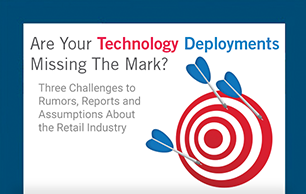 The shift to the cloud is here. More than (78%) of retailers are advancing or mature with their use of multi-cloud infrastructure. The benefits are clear: easy user access, cost savings, scalability, simplified maintenance and turnkey redundancy. It’s no wonder enterprises are moving to the cloud at such a rapid clip.
The shift to the cloud is here. More than (78%) of retailers are advancing or mature with their use of multi-cloud infrastructure. The benefits are clear: easy user access, cost savings, scalability, simplified maintenance and turnkey redundancy. It’s no wonder enterprises are moving to the cloud at such a rapid clip.
However, the transition to multi-cloud infrastructure is not always trouble-free, and making the leap definitely requires some planning. A 2022 study from Foundry points to challenges like increased complexity, unqualified staff and even increased costs. A clear head is required for effective cloud migration. Make sure you take time to outline a detailed plan.
No shotgun approaches
Moving applications one at a time can get complicated fast. Pick a host that can accommodate and scale with your operation. Start with your operation and the technologies that are critical to delivering to your customers. Categorize systems to understand what’s mission-critical versus support and make decisions from there based on what should be transitioned to the cloud and how it can be done securely.
Planning a migration should take no fewer than 30 – 60 days. Start by mapping the interactions between all servers. There may be a server installed in some remote corner of a store that hosts critical data, but the guy who installed it left years ago and it’s been largely forgotten. Yet if it hosts critical data and you start making changes, entire pieces of the operation can go down due to an oversight of that single server.
Look at your network and understand what lives where, who accesses it and how often. Evaluate the size and complexity of the applications you are shifting to the cloud.
Evaluate what belongs in the cloud and what doesn’t
Particularly when it comes to enterprise retailers, the transition to the cloud pertains to certain back-office and non-critical applications. While 78% of retailers may be transitioning to the cloud, that does not mean that 78% of their technology is currently cloud-based. It’s an important distinction. Not everything is well suited for transition to the cloud. Consider POS data, for example. Internet pipe with enormous data capacity would be required to upload thousands of transactions times thousands of stores. Same with live recorded video. Some in-store applications, for the time being, can be managed more easily and cost effectively via local servers. Start by assessing which applications can effectively be managed in the cloud. Identify bandwidth-intensive devices and applications and develop strategic on-site hosting those items in-house to ensure easy, dependable access.
Telaid is here to help you think through these and other considerations when mapping a transition to the cloud. Check out our study, 5 Trends Driving Lightspeed Retail Transformation, which highlights the shift to the cloud as one of the critical trend. Contact us to get help mapping your transition to the cloud.




